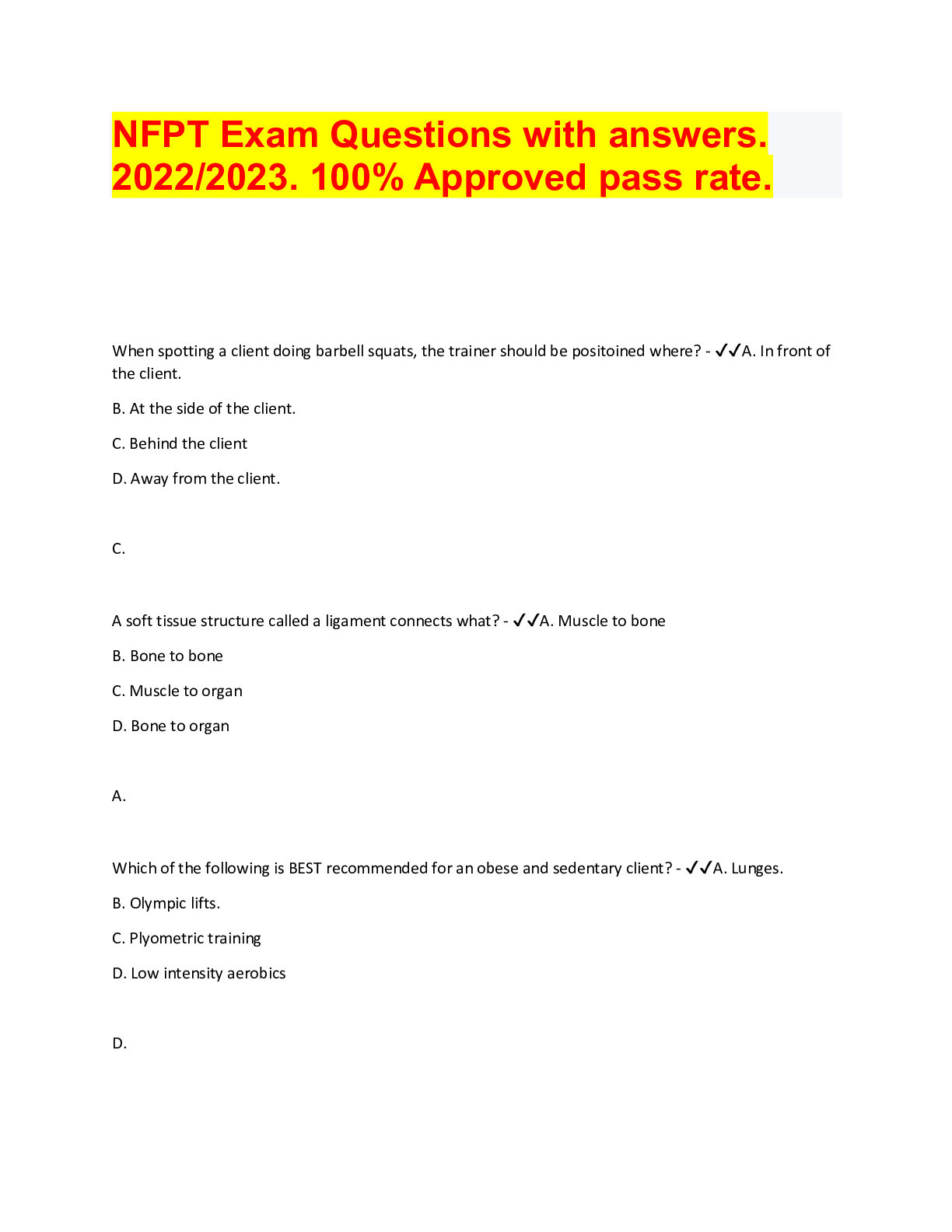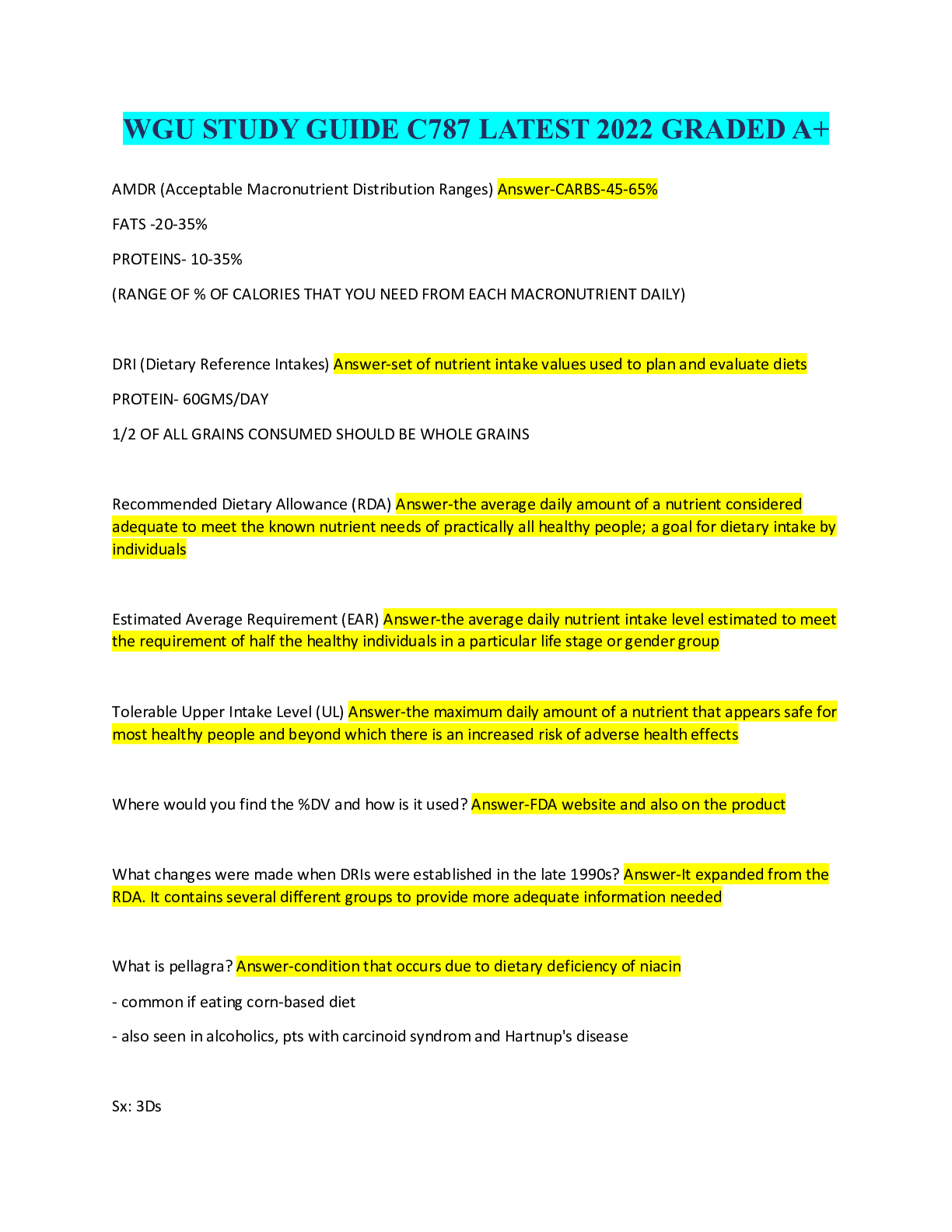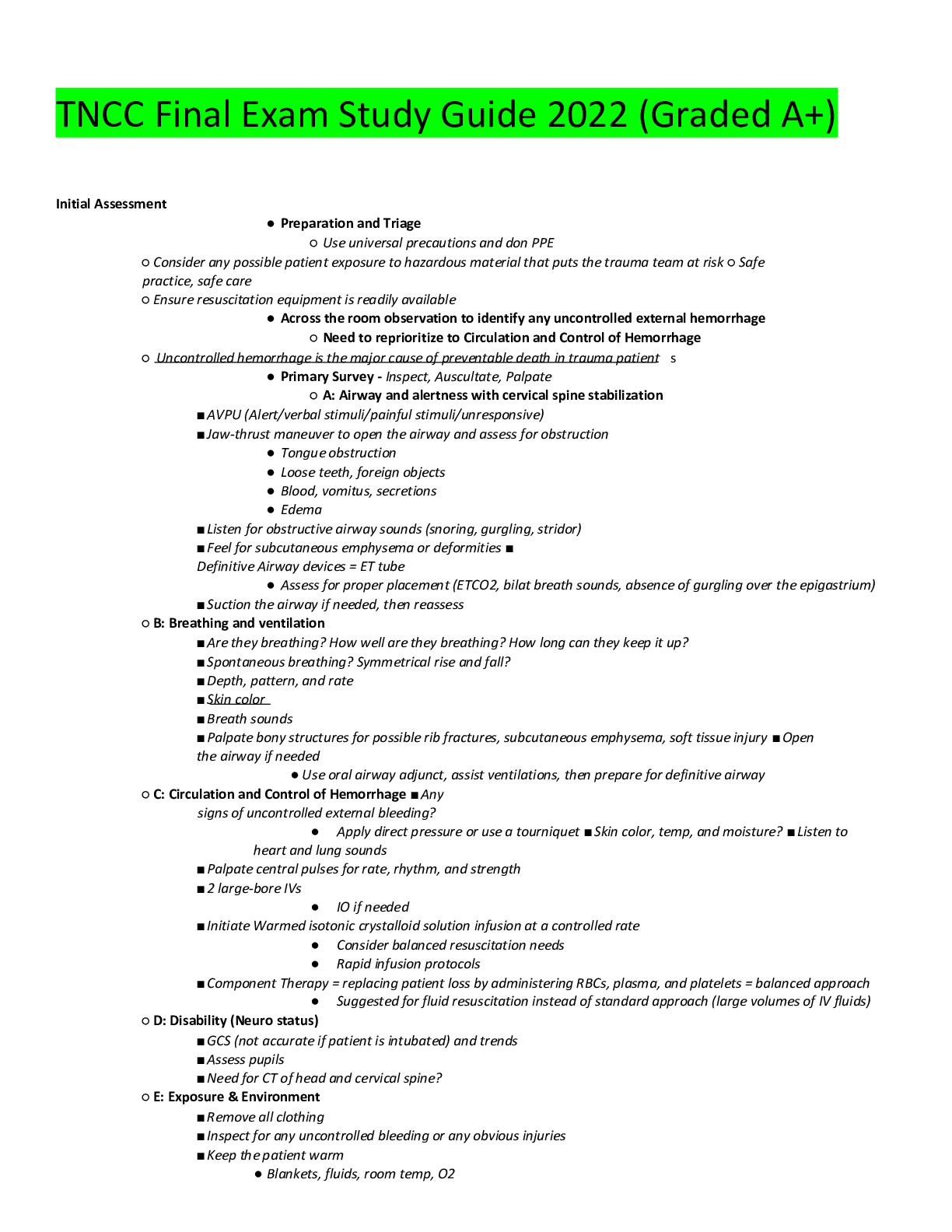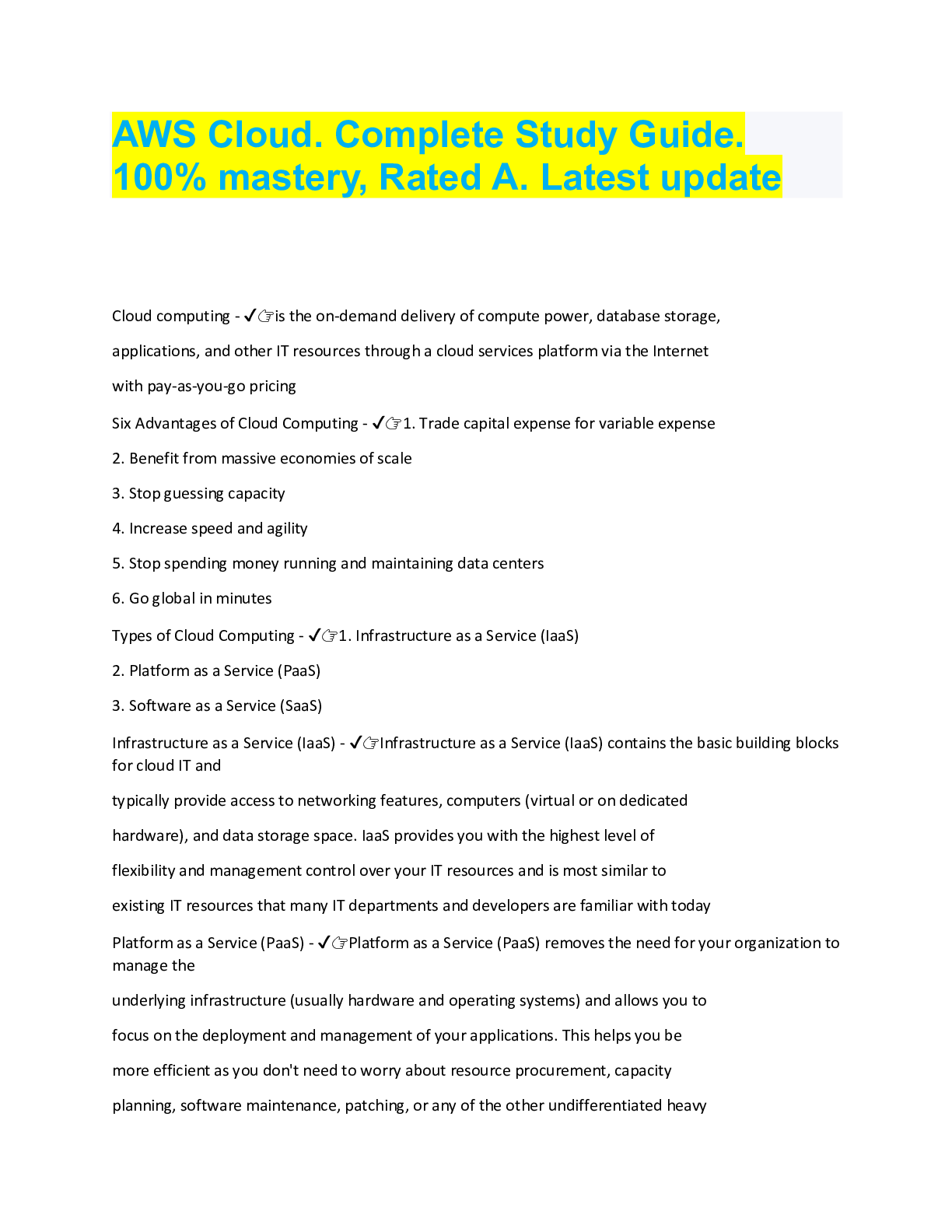Health Care > STUDY GUIDE > NFPT exam study guide. 100% Coverage. Graded A+ (All)
NFPT exam study guide. 100% Coverage. Graded A+
Document Content and Description Below
The five components of physical health - ✔✔Cardiorespiratory conditioning, muscular endurance, muscular strength, flexibility, body composition SPICES - ✔✔Social health, physical health, in... tellectual Health, cognitive health, emotional health, spiritual health Cardiorespiratory conditioning - ✔✔Endurance Muscular endurance - ✔✔The amount of strength that can be repeated several times Muscular strength - ✔✔The amount of strength in one repetition Flexibility - ✔✔The range of motion in given joints Body composition - ✔✔The amount of body fat relative to the total weight or as compared to the lean mass What are three additional factors that are specific to the fitness regimens of athletes and sports teams? - ✔✔Agility, speed and Mobility Intellectual health - ✔✔The capacity to assimilate and integrate new information into one's thinking and thought processes Cognitive health - ✔✔Often grouped with mental health as it has mostly to do with how we process information in the brain. It includes the way we see, or conceptualized, the world around it includes brain functioning in the areas of conceptual and perceptual skill, language learning as well as many other brain development functions Emotional health - ✔✔Includes self-esteem, self-awareness, self-acceptance, self-image and our capacities to deal with adversity and stress. This includes our ability to intimate, not just sexual, with a significant other. Spiritual health - ✔✔This is focused on the connection of ourselves with a higher power, a sense of purpose, self-actualization, and an inner Joy. It is often described as self-acceptance, repentance for misdeeds, a willingness to give to and forgive others and a desire to seek peace with the community and World overall Why is it important to touch on all things spices related as a personal trainer? - ✔✔Think about it and perhaps write a blog post What are the three categories of motivating factors for positive behavior - ✔✔Predisposing factors, enabling factors and reinforcing factors Predisposing factors include - ✔✔Knowledge, attitude, believe, values and perceptions Enabling factors - ✔✔Skills, resources, physical and mental capabilities Reinforcing factors - ✔✔Praise from others comma rewards, encouragement and recognition Which factors does the personal trainer typically fall into - ✔✔Reinforcing factors. We can recognize how the other two factors promote or inhibit positive behavior and we can work to reinforce positive behavior with forms of encouragement What are some things that can be added to life to invoke positive change? - ✔✔Taking time for Meaningful reflection, reading a book, being creative, socializing with friends and family, adding a physical component and healthy eating to daily living What areas of exercise therapy would require a highly trained exercise physiologist or physician to prescribe appropriate regimens - ✔✔Cardiovascular disease, respiratory disease, joint injury, or obesity / metabolic disorders which include diabetes and hypertension What is the purpose of muscles - ✔✔To produce Force, maintain posture, allow for movement and produces Heat All muscle action originates and is controlled by what? - ✔✔The brain which sends and receives signals through the nervous system What gets pulled during a muscle contraction? - ✔✔Tendons, the strong connective tissue that connects muscles to bones What are the two points of muscle - ✔✔Origin and insertion Define muscle origin - ✔✔The origin is considered the point at which the muscle joins the stationary bone at the end closest to the center of the body Define muscle insertion - ✔✔Insertion is the point at which the muscle joints moving boat. When a muscle contracts the insertion moves toward the origin How many muscles are in the average adult body - ✔✔656 muscles Muscles are joined together to form muscle groups to execute bodily movement. They can get shorter and pull but they cannot push. True or false? - ✔✔True In muscle groups, when one group pulls the other group pulls back and as one team pulls the other team relaxes. True or false? - ✔✔True What are the three muscle types? - ✔✔Skeletal, smooth and cardiac muscles What are the two subtypes of muscles? - ✔✔Involuntary and voluntary How many muscles are voluntary and how many bones do they control? - ✔✔430 of our muscles are voluntary controlling 206 bones Which type of muscles are voluntary? - ✔✔Skeletal muscles Which type of muscles are involuntary? - ✔✔Smooth and cardiac which include the cardio vascular tissue comma heart and blood vessels, and the lining of the intestinal and respiratory tracts What internal system supplies muscles with the necessary oxygen and nutrients to survive ? - ✔✔The cardiorespiratory system How many bones are in the adult body? - ✔✔206. We are born with 350 What are the five major functions of the skeleton? - ✔✔Protect vital internal organs; Sports our bodies framework, giving us an upright vertical shape; produces red and white blood cells in the bone marrow; stores minerals and fats; regulates mineral balance, releases minerals into the blood as needed What is the largest bone in the body? - ✔✔The femur, located in the top half of the leg it allows us to walk What are the rounded nodules, or outgrowths, on bones that generally act as sites for muscle insertions? - ✔✔Tubercles; for example, the tibial tuberosity creates an attachment point for the patellar ligament What is a joint? - ✔✔A joint is the location at which two or more bones come together for movement and mechanical support What is a ligament? - ✔✔Strong stretchy bands of fibrous tissue that hold joints together What is cartilage? - ✔✔Cartilage covers the ends of each bone and is a tough flexible connective tissue that has a smooth, shiny surface What is the name of the thin film of slippery fluid located between bones? - ✔✔Synovial fluid, keeps the bones from scratching and bumping against each other during movement Tendon - ✔✔Connects muscle to bone Ligament - ✔✔Connects bone to bone How many liters of blood does the human body contain ? - ✔✔4 - 5 liters Blood is the transport system by which oxygen and nutrients reach the body cells and waste materials are carried away. True or false? - ✔✔True Define hormones - ✔✔The regulatory substances transported in tissue fluids for stimulating specific cells that control the specific body process On which side of the heart does blood enter and what color is it - ✔✔Blood enters on the right side of the heart and is dark red almost bluish and is low in oxygen Blood travels from the right side of the heart along pulmonary arteries to the lungs, where it received fresh supplies of oxygen and becomes bright red period it then flows along pulmonary veins to the heart's left side pump. Blood then leaves the left side of the heart and travels to the rest of the body through arteries, going away from the heart, that gradually divide into capillaries. - ✔✔This is the circulatory system In relation to the heart, blood travels in which direction through arteries? - ✔✔Away from the heart In relation to the heart, blood travels in which direction through veins? - ✔✔Toward the heart What occurs in the capillaries? - ✔✔Food and oxygen are released to the body's cells, and carbon dioxide and other waste products are returned to the bloodstream. After which the blood travels through veins back to the heart and whole process starts again When we breathe the body takes in oxygen and removes what? - ✔✔Carbon dioxide What is the technical term for the windpipe and what purpose does it serve - ✔✔Trachea, allows passage of air into the lungs What is the name for the tubes that carry air into each lung - ✔✔Bronchi Bronchi divide into even smaller tubes called what - ✔✔Bronchioles What is the name for the small air sacs located at the end of each bronchiole and which I wrapped up by the capillaries - ✔✔Alveoli What is the respiratory system - ✔✔The body system that deals with breathing Our breathing process is controlled by which muscle - ✔✔The diaphragm which is located in the Torso underneath the lungs Is the diaphragm contracts does it expand or flatten - ✔✔It flattens, causing the chest to expand and air to be sucked into the lungs What test can you perform dtermine an individuals maximum oxygen intake in one breath - ✔✔VO2 max Which part of the nervous system is responsible for sending and receiving information to and from the entire body and consists of the brain and spinal cord - ✔✔The central nervous system which is the processing hub Which nervous system consists of nerves that attach to the CNS to the body's organs and extremities and acts as a messenger between the brain and the rest of the body - ✔✔The peripheral nervous system What is the sublevel of the pns - ✔✔Autonomic nervous system which operates involuntary voluntary motor nerve processes List the order of the digestive system - ✔✔Mouth, esophagus comma stomach comma pancreas, gallbladder, small intestine, liver, large intestine, rectum and anus Esophagus - ✔✔Is a muscular tube that takes food from the throat and pushes it down through the neck and into the stomach. It moves food by waves of muscle contractions called peristalsis Stomach - ✔✔The stomach has big muscles in its wall with contract too much food. The stomach secrete strong protein digesting juices and acids that attacked the food and a chemical whey breaking down and dissolving its nutrients. Once the food is broken down it will then move into the small intestine Pancreas - ✔✔Is a glandular organ in the digestive and endocrine system. In the digestive system it acts much like the stomach in that it makes powerful digestive juices called enzymes that for their break down food as it enters the small intestines. This is also where insulin and glucagon are released to control blood sugar levels Gall bladder - ✔✔This is a small bag like part that is tucked under the liver. It stores fluid called bile which is made in the liver. As food from a meal arrives in the small intestine bile flows from the gallbladder along the bile duct into the intestine. This vile acts especially to further digest fatty foods Small intestine - ✔✔This is where most of the absorption of nutrients occur. Nutrients are small enough to pass through the lining of the small intestine and into the blood. These nutrients are then carried away to the liver and other parts of the body to be processed stored and distributed Liver - ✔✔Blood from the intestines flows to the liver, carrying nutrients comma vitamins and minerals, and other products from digestion. The liver stores some nutrients, changes them from one form to another, and then releases them into the blood according to the activities and bodily needs Large intestine - ✔✔Useful substances in The Leftovers, such [Show More]
Last updated: 2 years ago
Preview 1 out of 23 pages

Buy this document to get the full access instantly
Instant Download Access after purchase
Buy NowInstant download
We Accept:

Also available in bundle (1)

NFPT bundle, Questions with accurate answers.
3 versions of examinable masterpieces, rated A+
By bundleHub Solution guider 2 years ago
$16
3
Reviews( 0 )
$8.00
Can't find what you want? Try our AI powered Search
Document information
Connected school, study & course
About the document
Uploaded On
Aug 15, 2022
Number of pages
23
Written in
Seller

Reviews Received
Additional information
This document has been written for:
Uploaded
Aug 15, 2022
Downloads
0
Views
97
















